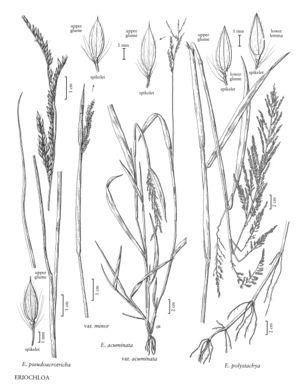Difference between revisions of "Eriochloa polystachya"
FNA>Volume Importer |
FNA>Volume Importer |
||
| Line 17: | Line 17: | ||
-->{{Treatment/Body | -->{{Treatment/Body | ||
|distribution=Puerto Rico;Fla.;Tex.;Miss. | |distribution=Puerto Rico;Fla.;Tex.;Miss. | ||
| − | |discussion=<p | + | |discussion=<p>Eriochloa polystachya is native to the West Indies, Costa Rica, Honduras, and South America. It was introduced into the United States as a forage crop and is now established at some locations in Florida and Texas.</p> |
|tables= | |tables= | ||
|references= | |references= | ||
| Line 33: | Line 33: | ||
|basionyms= | |basionyms= | ||
|family=Poaceae | |family=Poaceae | ||
| + | |illustrator=Linda A. Vorobik and Cindy Roché | ||
|distribution=Puerto Rico;Fla.;Tex.;Miss. | |distribution=Puerto Rico;Fla.;Tex.;Miss. | ||
|reference=None | |reference=None | ||
| Line 38: | Line 39: | ||
|publication year= | |publication year= | ||
|special status= | |special status= | ||
| − | |source xml=https:// | + | |source xml=https://bibilujan@bitbucket.org/aafc-mbb/fna-data-curation.git/src/314eb390f968962f596ae85f506b4b3db8683b1b/coarse_grained_fna_xml/V25/V25_1350.xml |
|subfamily=Poaceae subfam. Panicoideae | |subfamily=Poaceae subfam. Panicoideae | ||
|tribe=Poaceae tribe Paniceae | |tribe=Poaceae tribe Paniceae | ||
Revision as of 16:15, 30 October 2019
Plants perennial; cespitose, stoloniferous. Culms 100-200 cm, decumbent, rooting at the lower nodes; internodes glabrous; nodes 4-10, densely pilose. Sheaths chartaceous to cartilaginous, lower sheaths with papillose-based hairs, upper sheaths glabrous; collars hairy; ligules 0.6-1.2 mm; blades 6-28 cm long, 6-18 mm wide, linear, flat, straight, ascending or drooping, glabrous adaxially. Panicles 8-20 cm long, 41-90 mm wide, open; rachises sparsely pilose to hirsute; branches (5)10-15(18), 2-6 cm long, 0.4-0.6 mm wide, pubescent to setose, not winged, spikelets in unequally pedicellate pairs; pedicels 0.5-1 mm, pubescent, apices glabrous. Spikelets 3.2-3.9 mm long, 1.1-1.3 mm wide, lanceolate to ovate. Lower glumes present as a membranous extension of the calluses; upper glumes equaling the lower lemmas, hairy, lanceolate to ovate, 5-veined, acute, unawned; lower lemmas 3-3.5 mm long, 1.1-1.3 mm wide, lanceolate to ovate, glabrous or sparsely pubescent, 5-veined, acute, unawned; lower paleas fully developed or absent; anthers absent or 3; upper lemmas 2.2-2.6 mm, indurate, elliptic, rounded, mucronate, mucros less than 0.2 mm; upper paleas 2-2.5 mm, indurate. 2n = 36.
Distribution
Puerto Rico, Fla., Tex., Miss.
Discussion
Eriochloa polystachya is native to the West Indies, Costa Rica, Honduras, and South America. It was introduced into the United States as a forage crop and is now established at some locations in Florida and Texas.
Selected References
None.
